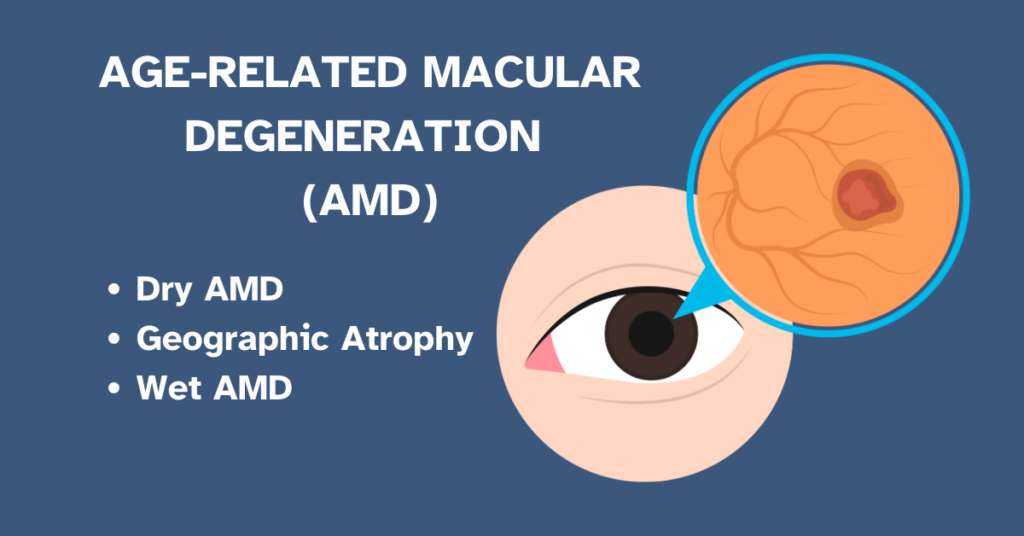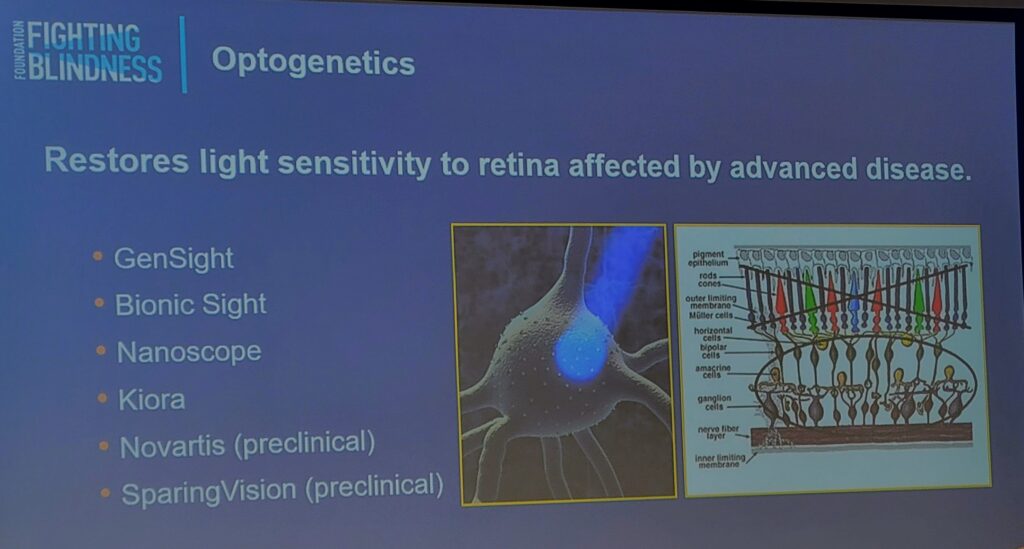
Age-related macular degeneration (AMD) is one of the most prevalent conditions that we see patients with. The currently available statistics highlight its prevalence and impact in the United States. Now, around twenty million Americans contend with AMD, and 1.5 million of them grapple with the advanced stages of the disease. There is a concerning trajectory- between 2010 and 2050, the estimated number of people diagnosed with AMD is expected to more than double, rising from 2.1 million to 5.4 million. Considering these figures, it is important to know more about AMD and its different types and stages, including wet AMD, dry AMD, and geographic atrophy.
By staying informed and proactive, you can take control of your eye health and work towards a future with clearer vision.
The Basics of Macular Degeneration
The macula is a small but crucial part of the retina responsible for sharp, central vision. AMD occurs when the macula deteriorates, causing blurred or distorted vision. There are two main types: wet macular degeneration and dry macular degeneration. All cases of macular degeneration begin as dry macular degeneration. Of those cases, 10-15% progress to wet macular degeneration.
Risk Factors for Age-Related Macular Degeneration
Though the exact cause of macular degeneration is unknown, several risk factors have been identified.
- Being 50 and older
- Certain genetics
- Eating an unbalanced diet high in saturated fat
- Smoking
- High blood pressure or hypertension
Symptoms of Age-Related Macular Degeneration
Each person may experience different symptoms, some of which are also present in other eye conditions. Seeing your regular optometrist for your regular comprehensive dilated eye exam is the best way to get a proper diagnosis and attention.
- Blurry or fuzzy vision
- Straight lines appear wavy. If you need help determining if this is happening, you can download an Amsler grid to test each eye.
- A dark, empty area or blind spot. The appearance of blurry or distorted spots in your central vision may impact your ability to drive, read, see faces, or do things at a near distance.
Prevention of Age-Related Macular Degeneration
- Eat nutrient-rich diet
- Take eye vitamins
- Don’t smoke
- Wear UV-protected eyewear and visors
- Attend regular comprehensive dilated eye exams for early detection and prevention
Dry Macular Degeneration: The Gradual Onset
Dry AMD progresses slowly and is characterized by light-sensitive cells of the macula slowly breaking down and the accumulation of drusen, yellow fatty deposits under the retina. Drusen can interfere with the normal function of the macula, leading to a gradual loss of central vision. Drusen are visible to your optometrist in a routine eye exam during the early stages of development.
Patients with dry macular degeneration may notice changes like the need for brighter light when reading, difficulty recognizing faces, or the appearance of blurry or distorted spots in their central vision. While dry AMD can cause significant visual impairment, it usually develops over a long period, allowing individuals to adapt to the changes.

Geographic Atrophy
Geographic Atrophy (GA) is the end-stage of dry AMD that can lead to permanent vision loss. During this stage, the widespread damage caused by drusen results in the formation of deteriorating and dead cell regions (atrophy) that look like blind spots in the person’s central vision. The condition can impact one or both eyes, and people with the disease in one eye are more likely to develop it in the other. Approximately 20% of people with AMD progress to develop geographic atrophy.
While GA is more frequently linked to dry AMD, it’s noteworthy that a patient can simultaneously experience both wet and dry AMD. Therefore, the development of wet AMD does not guarantee immunity from the possibility of getting geographic atrophy.
It is estimated that roughly one million people living in the U.S. have geographic atrophy.
For both Dry AMD and GA, your regular eye doctor will diagnose and monitor the progression at your regular eye exams. Special imaging tests and techniques are used for monitoring.
Wet Macular Degeneration: The Rapid Onset
Wet AMD is also known as neovascular macular degeneration. Though less common, it is more severe and leads to 90% of legal blindness. Unlike dry AMD, wet AMD involves the growth of uncontrolled and abnormal blood vessels beneath the retina. These vessels are fragile and prone to leaking blood and fluid, causing rapid damage to the macula.
If left untreated, wet AMD can progress rapidly, making early detection and intervention crucial.
People with wet AMD may not experience noticeable symptoms until the disease has advanced. Early diagnosis through advanced imaging techniques and prompt treatment, often involving injections to stop the growth of abnormal blood vessels, can help preserve vision for the best possible result.
Collaborative Management for Better Vision
As with most low vision conditions, there are several players, starting with your general optometrist and attending your regular comprehensive dilated eye exams. Once AMD is properly diagnosed professionally, your optometrist may refer you to a retina specialist (a type of ophthalmologist) for further diagnosis and treatments. If your macular degeneration is hampering your ability to do the things you enjoy, like drive, read, see faces, or watch tv, you should call our office for a free low vision phone evaluation (888) 882-2040 to see if the types of glasses Dr. Palmer prescribes can help. For some, losing their vision can be very isolating, and seeing a mental health professional can help. There are also vision rehabilitation agencies like Vision Loss Resources and Minnesota State Services for the Blind that offer resources for navigating your everyday life with vision loss and social and emotional support. Regular monitoring, lifestyle adjustments, and adherence to prescribed treatments are essential to a comprehensive care plan.
The Future of Macular Degeneration Treatment

As a low vision optometrist, Dr. Palmer is excited about the ongoing research and advancements in macular degeneration treatment. Emerging therapies, including gene therapy and stem cell treatments, hold promise for both wet and dry AMD, potentially providing more effective and targeted interventions in the future. As he says, “I’d like to be put out of business!” That is why we at Low Vision Restoration support the work of the Foundation Fighting Blindness by participating in their events and fundraisers.
If you or someone you know has a form of macular degeneration, we may be able to help you lead the best life possible with the help of low vision glasses. Dr. Palmer has helped countless people regain the ability to drive, read sheet music, do their favorite pastimes, and more. Schedule your free low vision phone consultation (888) 882-2040 to find out if our solutions could help you.


